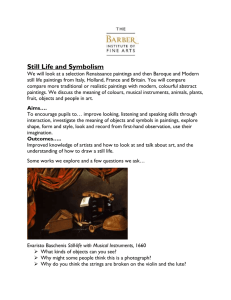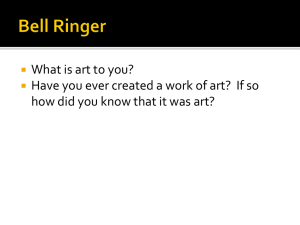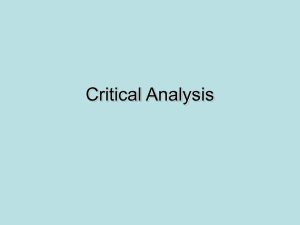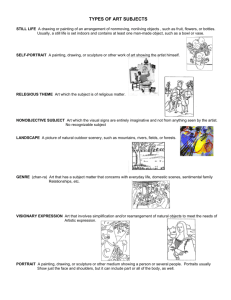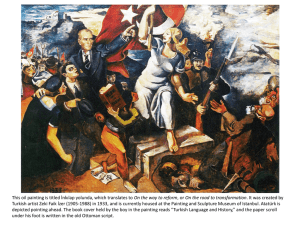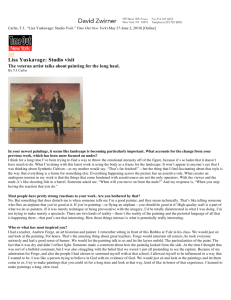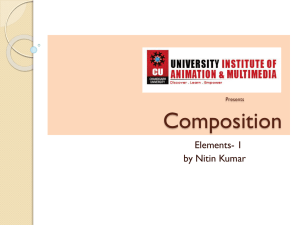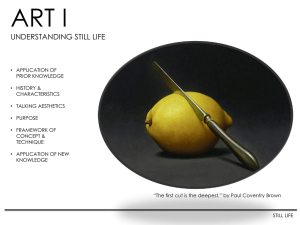,-
advertisement
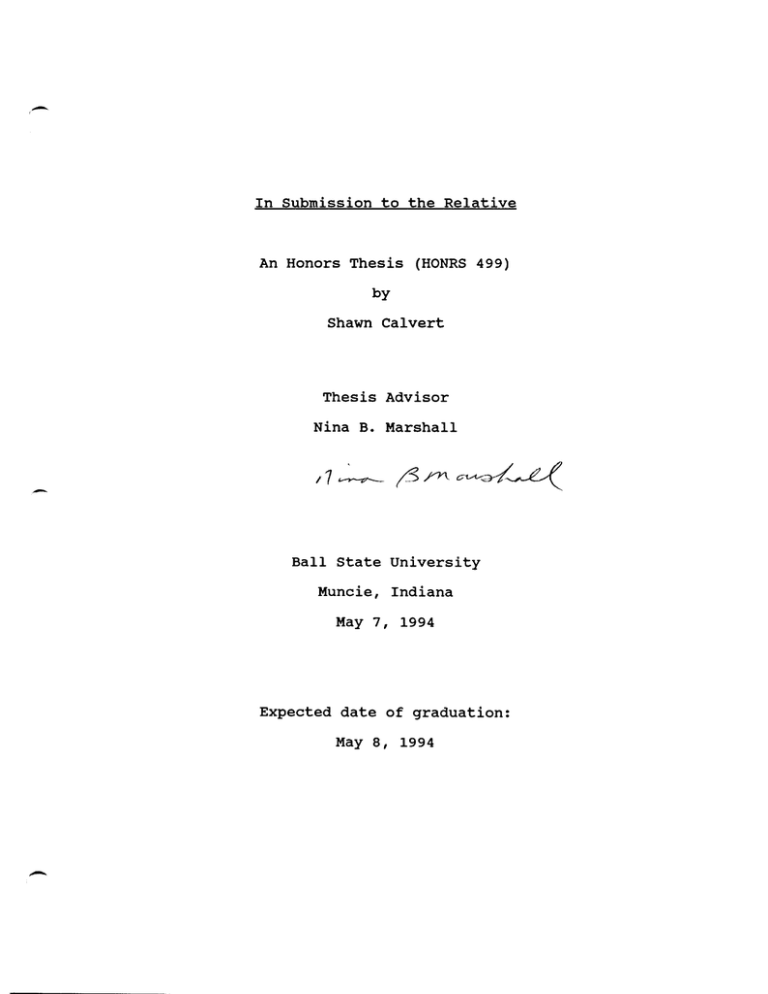
,In Submission to the Relative An Honors Thesis (HONRS 499) by Shawn Calvert Thesis Advisor Nina B. Marshall Ball State University Muncie, Indiana May 7, 1994 Expected date of graduation: May 8, 1994 " ,,, ""f' /' ; --i't'. L - Purpose of Thesis This thesis consists of both a written essay and a series of paintings. In the essay I briefly outline the influences that have altered my perceptions of visual art, and painting specifically, during my five years of undergraduate study. The paintings are a culmination of these influences. - - In Submission to the Relative Although the "naturalness u of any act or value can be, and has been, debated, I feel strongly that the human desire to create visual images is a natural impulse. The memories I possess of my early encounters with drawing and painting are incomplete and perhaps altered, but I depend upon those early memories to understand my need to express myself in visual terms. When I discovered for the first time the use of pencils or crayons, not have a prem~ditated I did aesthetic battle plan. I was free to develop my own methods, or codes, of representation. As I became more involved in the operations of society, these codes, as well as my understanding of visual art, were shaped by conventionalized codes of representation. These codes reveal themselves in statements like, draw a nose. u "THAT is not how to draw a nose, THIS is how to I accepted these conventions at the time to be the "natural u order of things, despite my own experiences. I do not attempt to recall my romanticized, cloudy childhood memories for the purpose of lamenting a time of lost innocence, but as a model ~or my later experiences in the visual arts. The process I have gone through over my five years in college in understanding the role and significance of visual images for myself and society has been both additive and subtractive.Stated less abstractly, I have continually accepted and formed perceptions which I would later revise or abandon entirely. My college years have introduced me to the history and the conventions of the visual arts which had not existed for me beforehand. Just as when I came upon the codes of representation as a child, I have been presented with the codes of the visual fine arts in college, and the effects have left me somewhat disoriented in my position as a visual artist. I cannot assess the extent of change I have undergone while in college, but in this paper I hope to review some of the factors that have shaped and influenced my understanding of the meanings and potential of visual art, or painting specifically. As I entered my first year of art history, I had not realized the complexities of the discipline. At that time, "modern H was synonymous with "contemporary," and art history was the anecdotepacked history of art objects stashed in museums and the eccentric persons who made them. It now seems fitting that the first essay I encountered of modernist art theory was Clement Greenberg's "Avant-Garde and Kitsch." In this essay Greenberg outlines his reductive modern recipe for ART, drawing a solid line between true culture and simulated, or kitsch, culture. In order to make high art, the artist must "turn his attention away from subject matter or common experience, the poet or artist turns it in upon the medium of his own craft." Greenberg claimed that all great modern painters "derive their inspiration from the medium they work in." He proposed that painting should isolate itself from all other disciplines, and turn in upon its bare essences, as should all other artistic mediums. By stripping down and holding up these pure artistic creations, society will progress towards something or other that hints at utopia. Greenberg and the abstract expressionists, whom had also encountered at the time, gave me the impetus to take a non- - representational direction in my painting. The shift to a non- 2 representational shift was part romantic affiliation to the abstract expressionist and part simple assimilated style. I never truly believed in the "heroic" war between high art and kitsch, mainly because I found much pleasure in art forms that would have been classified as kitsch in the Greenberg hierarchy. painting, In my I have realized that my early experiences with Mad magazine, super-hero comic books, Hannah Barbara cartoons, and illustrated Biblical storybooks, have left a deeper impression on my artistic sensibilities than any "high art" experience. I do not recognize a solid line between art and kitsch; artistic inspiration can be found in any medium or context. It is unfortunate that so many of artists, galleries, critics, and museums alienate the society they propose to represent. After a heavy dose of modern American art theory, I took a historical step backwards and encountered the avant-garde of preStalin Russia. Greenberg and like-minded others promoted the ideal artist as an individual who paints in solitude, searching for the next formal discovery. Greenberg's ideal for art was one that had been rejected in Russia in favor of more practically useful one. The Russians had, about twenty years earlier, proposed the artist's role to be that of a collective worker manufacturing visual icons for the good of the entire society. Although he did not represent the Russian avant-garde as a whole, Wassily Kandinsky was the first individual Russian artist I studied in depth. The ideas he expressed in Concerning the Sgiritual in Art were a revelation in comparison to Greenberg. Whereas Greenberg portrayed the modern artist as the overman battling against the herd, Kandinsky portrayed the artist as a 3 sort of spiritual prophet, creating signposts to spiritual enlightenment. Although it could be said that Kandinsky's theories led to a reductive litany not entirely unlike Greenberg's in effect, I believe his theories to have non-constraining intentions at their roots. Kandinsky believed that the paint could be a potent "medium" between the physical and spiritual. Painting as anti-materialistic response, as "visual music", or as spiritual nourishment were some of the abstract ideas I had been unconsciously seeking in my painting, just as I had sought them in Christianity. I wanted my paintings to become my missionary work, although I was not quite sure what I was preaching. Looking back now, I can see that this "higher purpose" instilled an initial drive within me to become serious about my painting. When my "faith" in painting wavers, my growth as an artist suffers as well as the satisfaction I feel when I finally complete a work. Unlike Kandinsky, I do not believe my function as a painter is to lead anyone to enlightenment, or that painting can be a vehicle to salvation of any kind. Although I am wary of all the various objective charts and graphs outlining the effects of color on human emotions, Kandinsky's association of color and music seems to have merit. Color creates a covert effect upon the human psyche that is inescapable; music seems less covert, yet the effect is similar. As I train myself to become more aware of how colors shift my perceptions, I am intimidated by its potential. I often desire to be in the dark to escape color "noise." Music and painting also seem to share other qualities also, despite the temporal/plastic contradiction. No one asks the musician, "What does that note 4 mean?H because music is its own justification. In my opinion. music has never been at ease with narrative and representation, yet painting is linked to them through convention. Inspiration to make music and paint are not unlike one another, and I have often wondered if I would have been happier if I had gone into music. The dichotomy between inspiration leading to creation and the creation made base through language is an unescapable truth of imperfect communication. While I was stimulated by Kandinsky's mystical approach to painting, I was also fascinated by his Russian contemporaries who formed the various national art organizations after the October revolution of 1917. Artists such as Kazimir Malevich, Aleksandr Rodchenko, and Vladimir Tatlin were a few of the leading Russian artists involved in such dramatically named groups as the Institute of Artistic Culture, Russian Academy of Artistic Sciences, and the Visual Arts Section of Narkompros. These artists and institutions received the sanction and funding of their government to develop a people's art, with true faith in art's power to elevate society. Here is the one time in modern art history that theory was given the opportunity to become practice. It makes for good speculation to pretend that the great utopian dream of Russia had succeeded- What level of visual culture would they have attained? There are parallels between the path of the Russian avantgarde and Greenberg's theories as outlined in "Avant-Garde and Kitsch.H Considering that Greenberg held a covert Marxist agenda is surely a factor. It seems that the fate of the Russian avant- garde should have been enough proof that Greenberg's theories were 5 not practical in application. The various Russian/Soviet artistic institutions sought to find objective and scientific nature of art without the interference of psychological interpretations. "Pure painting," as the Constructivists had interpreted it, leads to "art is dead." The Russian avant-gar~e and Greenberg both viewed art history as leading to a point, and believed their theories to be that point. What would happen after that point is reached was left unclear. The Institute of Artistic Culture voted on November 24, 1921 that easel painting was useless within a collective society. In an industrial, utilitarian-minded society, the sUbjective nature of easel painting does nothing but hinder progress. Later in 1921, governmental sponsored avant-garde activity was eliminated in favor of socialist realism. The triumph of the social realism over the avant-garde in Russia is a model example of the conflicts between realism and abstraction, collective society and the individual, poetry and propaganda, and functional artworks and non-functional artworks. As I encountered different, and often conflicting, histories of art and artists, my own painting followed a long series of illogical directions. In part I wanted to believe in "pure painting," yet deep down I felt alienated and disinterested in the concept. I also wanted to somehow use my painting skills in less self-indulgent contexts, as I increasingly felt that easel paintings were luxury objects with no effective didactic or utilitarian potential. After being given the opportunity to design and execute a mural last year, I feel that my skills can be useful within my society, and I dearly hope I will be given the 6 opportunity again. At the base of my ongoing artistic identity crisis was what I had understood to be a conflict between realistic representation and non-representational abstraction. On one hand, I believed that the devices of representation were tools of illusion that only served to "trick" the viewer, and that representational painting was inferior to photography, film, and sculpture. On the other hand, I believed that these devices were firstly a shape and secondly a representation, and that I could be equally moved by a good painting regardless of representation and abstraction. This year my awkwardness between representation and abstraction began to clear when I was introduced to writings that directly concerned photography and indirectly concerned all forms of representation. The general stance of these writings, which included Roland Barthes' Camera Lucida, was that all photographs are dependent upon their referents, and that all photographic meaning is dependent upon the context of the photograph. Poststructualist theory, of which Barthes was a leading proponent, places meaning upon the relative perceptions of the viewer, which, in effect, positions the viewer as the subject. Meaning is therefore derived from a series of texts, of which the material photograph is only one. This theory is easily applied to photography, which is often thought to copy reality. But to what extent does it apply to painting, which is conventionally thought to create reality? The qualitative differences between painting and photography had always seemed evident before I began to question my own sources of inspiration. When I am drawing or painting, regardless 7 of the degree of non-representation I may be attempting, somewhere in the back of my mind I am referring to an image I have derived from reality. Even if I were to believe that I could bypass my conscious mind and draw directly from the unconscious mind through automatism, that unconscious mind is still dependent upon referents in observed reality. Drawing and painting are no less dependent upon imitating reality than photography, only the source of the referents may differ. One concept I have learned to be impossible is the "pureness" of any image, visual or sculptural. Every image encountered by a viewer will be at the mercy of the mental referents and perceptions brought into the image's context by the viewer. Any abstract image submits itself to setting up a dialogue similar to a Rorshach test or cloud reading. For example, the primary separation between Malevich's Supremacist black square paintings or the early work of Frank Stella and decorative wallpaper is large amounts of non-visual texts generated by the artist and others involved in art production. When confronted with an "alien" image, the viewer will either: 1) relate the image to a similar visual image, 2) accept the image as a sign to other texts, or 3) ignore the image entirely. Because meaning is derived from a multitude of texts other than the art object itself, the artist must attempt to understand the basic codes within society that will determine meaning. All images are subject to the relative perceptions of each individual viewer, but not all images are equally relative. The codes of representation can be essential tools in directing connotative and - denotative meaning, depending upon the level of ambiguity the 8 -- artist wishes to allow. If the visual artist wants to represent a human face then the code of "that is a nose" is essential in directing the viewer to the intended meaning. After five years of undergraduate study, I feel that my motivation in creating visual imagery has begun to return to my initial motivations as a child. Painting should only be limited by the abilities of the painter, not by exterior forces. Visual art is both liberating and terrifying in its potential as I understand the lack of absolutes within its realm. My training within an educational institution has shaped my understanding of visual art according to collective perceptions, but I view this training as an essential tool in creating more personally satisfying visual imagery. The need for art to be socially relevant does not need to be an overt or forced process. I cannot escape my society or the fact that I am a part of that society, therefore it follows that my art will also reflect a portion of the concerns of that society. The works created during this semester represent a repositioning of my intentions and methods as a painter. The processes used in creating these paintings was perhaps more satisfying than the resulting image. The paintings were created by the traditional additive process of applying paint with brushes, sponges, and other tools; as well as subtractive methods using sandpaper and oven cleaner. By approaching painting as both an additive and subtractive process, the paintings reflect more accurately the process of education and life in general. Most of the paintings in this series are revisions on older, less successful, paintings. Each painting contains its own theme, like -9 -- a single thought carried out in physical form. They are joined together by the abstract theme of "the origins of things," referring to both physical/spiritual and personal/universal origins. In order to realize my ideas, I allowed myself to utilize elements in my paintings that I had restricted myself from previously, including found objects, photographs, and human forms. As I have "submitted" to the relative nature of visual imagery, my paintings have become more truthful representations of my perceptions. Although I do not desire to entirely control others' perceptions of my images, even if it were possible, I feel a need to be accurately understood to some degree through my art. I still get a great deal of pleasure from the act of painting itself and the physical qualities that are unique to the medium, but I also want them to work on other levels as well. I hope that these works mark an end to the restrictions I have inflicted upon my paintings, and a return to the liberating, create visual images. -- 10 "natural" need to Bibliography Barthes, Roland. Camera Lucida. New York: Hill and Wang, 1981. Berger, John. Ways of Seeing. London: Penguin, 1972. Bolton, Richard, ed. The Contest of Meaning. Massachusetts: The MIT Press, 1989. Bowlt, John, ed. Russian Art of the Avant-Garde. New York: Thames and Hudson, 1976. Chipp, Herschel B. Theories of Modern Art. Berkeley: University of California, 1968. Greenberg, Clement. "Avant-Garde and Kitsch," Pollock and After: The critical Debate. Francis Francina, ed. London: Harper and Row, 1985. Kandinsky, Wassily. Dover, 1977. Concerning the Price, Sally. Primitive Art in University of Chicago, 1989. Spiritual civilized in Art. Toronto: Places. Chicago: Wallis, Brian, ed. Art after Modernism. New York: New Museum of Contemporary Art, 1984. - Senior Exhibition How to Digest Narrative of a Cheeseburger. This is one of my approaches to painting as an additive and subtractive process. Education is a process of addition and subtraction, a pattern echoed in every aspect of life. The decision to "clean off u or paint over many of my paintings helped me to envision the images more clearly. Germ in Hand One of the paintings underneath this image was entitled Day at the Fair, a title that seems more appropriate for this current version. Theme: "the origin of things. u ~ Morning, then Night On the relationship between seeds and produce. Blanked During the making of several of these paintings I often wondered who was in control; myself or the materials. As my family was cleaning out my grandfather's garage, I came upon two letters, "A," and "M.u The perfect word. I learned to allow these discoveries to step into my work and not question how or why I came upon them. The Day We Nearly Died Commemorating the day my grandmother, brother and I almost went over the rainbow- an interpretation made after the fact. The various paintings sleeping underneath this image are now residue swept up in the storm. Landscape On the relationship between seeds and livestock. Creator 3x3+3x3= excessive like the gold frame. Many things are round, including basketballs and planets. I had intended to deal with the "insides u or the "origins of thingsu again with this painting. This painting grew out of my father's high school basketball picture, which I included in the painting. Did He Watch Her Drown? Somethir.' mysterious lies in them there waters, don't you go nosin' around. Portrait of an Infection The differences between photography and drawing/painting have become greatly obscured. "What is real" or "what is true u in visual art of all media no longer seems to be a worthwhile question. 11
